
Jigging is the practice of fishing with a jig, a type of fishing lure. A jig consists of a lead sinker with a hook molded into it and usually covered by a soft body to attract fish. Jigs are intended to create a jerky, vertical motion, as opposed to spinnerbaits, which move through the water horizontally. The jig is very versatile and can be used in both salt and fresh water. Many species are attracted to the lure, which has made it popular among anglers for years.

Fly tying is the process of producing an artificial fly used by fly fishing anglers to catch fish. Fly tying is a manual process done by a single individual using hand tools and a variety of natural and manmade materials that are attached to a hook. Although the recent history of fly tying dates from the middle 1800s, fly tyers were engaged in tying flys since at least 200 AD.

An artificial fly or fly lure is a type of fishing lure, usually used in the sport of fly fishing. In general, artificial flies are an imitation of aquatic insects that are natural food of the target fish species the fly fishers try to catch. Artificial flies are constructed by fly tying, in which furs, feathers, thread or any of very many other materials are tied onto a fish hook.
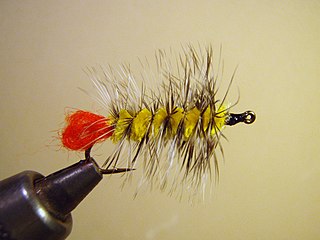
The Woolly Worm is an artificial fly commonly categorized as a wet fly or nymph and is fished under the water surface. It is a popular pattern for freshwater game fish and was a very popular fly in the 1950s–1970s in the west. Charles Brooks in Nymph Fishing for Larger Trout recommends the Woolly Worm as a general purpose nymph pattern in most western trout waters in any fly box. Woolly Worms are typically fished in streams, rivers, ponds, and lakes for trout, bass, and panfish. Today, Woolly Worms are tied in a variety of styles and colors to imitate a large aquatic nymphs such as stoneflies, dragonflies, damselflies or hellgrammites.

The Grey Ghost Streamer is an artificial fly, of the streamer type. Its primary function is to imitate smelt. The streamer's wing gives it a swimming action while trolling or using the Dead Drift technique.

A hackle is a metal plate with rows of pointed needles used to blend or straighten hair.
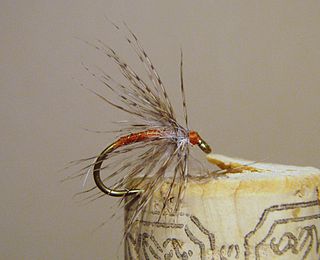
The Partridge and Orange is an artificial fly commonly categorized as a wet fly or soft hackle and is fished under the water surface. The fly is a very well known fly with its roots set firmly in English angling history. It is an impressionistic pattern fished successfully during caddis hatches and spinner falls. The Partridge and Orange is traditionally a trout and grayling pattern but may be used for other aquatic insect feeding species.

The Royal Coachman is an artificial fly that has been tied as a wet fly, dry fly and streamer pattern. Today, the Royal Coachman and its variations are tied mostly as dry flies and fished floating on the water surface. It is a popular and widely used pattern for freshwater game fish, particularly trout and grayling. Large streamer versions are also used for winter steelhead and Atlantic salmon.

Tenkara fly fishing is a simple type of fishing practiced in Japan. Primarily used for mountain stream trout fishing, tenkara is still a fairly rare method of angling among fresh-water mountain anglers in Japan. Most use bait.
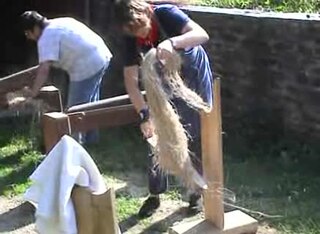
Heckling is the last of three steps in dressing flax, or preparing the fibers to be spun. It splits and straightens the flax fibers, as well as removes the fibrous core and impurities. Flax is pulled through heckling combs, which parts the locked fibers and makes them straight, clean, and ready to spin. After heckling and spinning, flax is ready to be woven into linen.
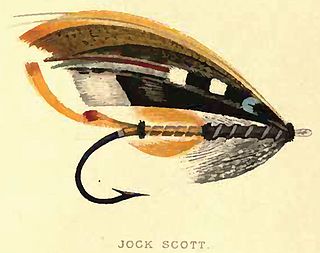
Fully dressed flies are elaborate and colorful artificial flies used in fly fishing. The most famous of these are the classic salmon flies, which are exquisite patterns made from mostly rare and beautiful materials and feathers, including golden pheasants, toucans, swans, and ivory-billed woodpeckers. These flies have been popular in the United Kingdom since the 19th century. Fully dressed flies are often meant for display and are not used in actual fishing. Many patterns are expensive to tie because of the cost of rare feathers.

The Elk Hair Caddis is a dry fly commonly used for trout fishing. The Elk Hair Caddis was created by Pennsylvania fly tyer Al Troth in 1957. He is considered a pioneer in the sport of fly fishing for this invention.

The Adams is a traditional dry fly primarily used for trout. It is considered a general imitation of an adult mayfly, flying caddis or midge. It was designed by Leonard Halladay from Mayfield, Michigan in 1922, at the request of his friend Charles Adams. The Adams has been considered one of the most popular, versatile, effective and best selling dry flies since its creation.
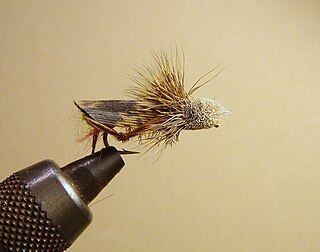
Dave's Hopper is an artificial fly used for fly fishing, designed to imitate adult grasshoppers and other Orthoptera species. It is considered a dry fly terrestrial pattern. It was designed by fly tyer and angler Dave Whitlock, and combines the best aspects of Joe's Hopper and Muddler Minnow patterns.
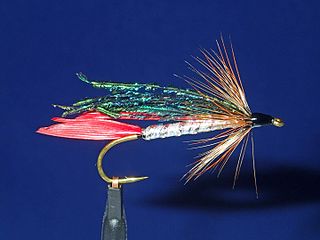
The Alexandra wet fly originated in Scotland in the 1860s. The artificial fly is also known as the Lady of the Lake, the fly was named by English angler Major William Greer Turle to honor Alexandra, Princess of Wales. The fly is distinguished by the heavy peacock herl wing and silver body which makes the fly resemble a small baitfish or fry. The Alexandra proved to be a very effective fly for trout in lakes and streams in England and Scotland in the late 19th and early 20th century. Many fly fishing purists derided the fly and its use was once banned on many English waters.

The Sakasa Kebari or reverse-hackle fly is an artificial fly most associated with the Japanese style of tenkara fishing but can be used in most freshwater fly fishing. The Sakasa Kebari is usually defined by firstly its reverse hackle and secondly by its simplicity as compared to western style flies. This fly was originally created to be used in the small, high gradient streams in Japan while fishing for native trout and char.

The Red Tag is an artificial fly originally designed as a dry fly for grayling and trout in the north country of England. The fly pattern, when introduced into Australia, particularly Tasmania, became extremely successful and popular for brown trout and remains today as one of the most essential flies for Australian fly anglers.

The Wulff series of dry flies evolved from a dry fly style conceived by angler Lee Wulff in the 1930s.

The Humpy fly is a popular and effective dry fly used by fly anglers for trout in fast-water conditions.

Terrestrial flies are a broad group of artificial flies used by fly anglers to imitate terrestrial insects that fall prey to fish in rivers, streams and lakes. Most typical are patterns imitating grasshoppers, crickets, ants, beetles, leaf hoppers, cicadas and moths.



















